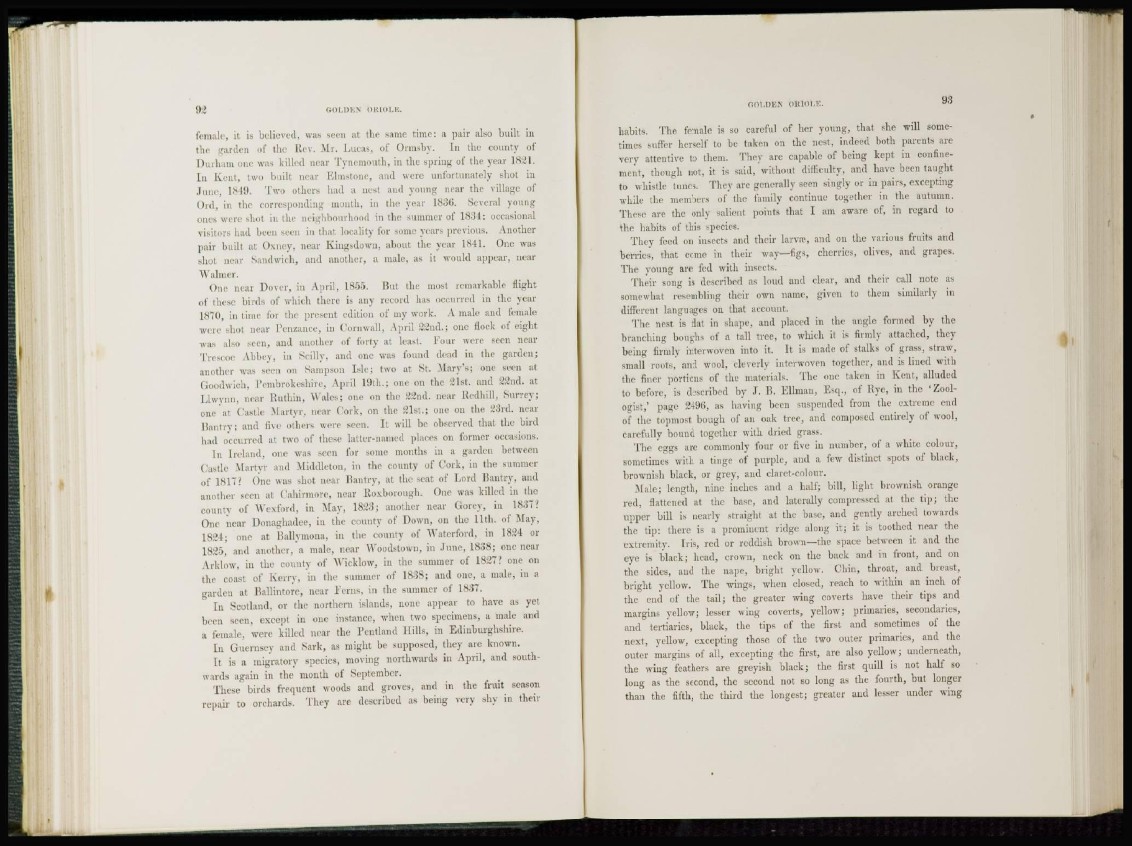
9 a GOLDEN ORIOLE.
female, ii is believed, was seen at tlie same time: a pair also built in
the garden of tin- Rev, Mr. Lucas, of Orinsby. In the county of
Durham one was killed near Tynomouth, in the spring of the year 1821.
I n Kent, two built near Elm.stonc, and were unfortunately shot in
.1 u i i e , IMS). Two olhers had a uesl and young near the village of
Ord, in the corresponding mouth, in the year 1836. Several young
ones were shot in the neighbourhood in tin1 summer of is.! I: occasional
visitors had been seen in that locality for some years previous. Another
pair built at Oxney, near Kingsdown, about the year 1841. One was
shot near Sandwich, and another, a male, as it would appear, near
\\ aimer.
One near Dover, in April, 1855. But the most remarkable flight
of these birds of which there is any record has occurred in the year
1870, in time for the present edition of my work. A male and female
were shot near Penzance, in Cornwall, April 22nd.; one flock of eight
was also seen, and another of forty at least. Four were seen near
Trescoe Abbej. in Seilly, and one was found dead in the garden;
another was seen on Sampson Isle; two at St. Mary's; one seen at
Goodwich, Pembrokeshire, April 19th.; one on the 21st. and 22ud. at
Llwynn, near Ruthin, Wales; one on the 22nd. near Kedhill, Surrey;
one at Castle Martyr, near Cork, on the 21st.; one on the 23rd. near
Pantry; and five others were seen. It will be observed that the bird
had occurred at two of these latter-named places on former occasions.
I n Ireland, one was seen for some months in a garden between
Castle Martyr and Middleton, in the county of Cork, in the summer
of 1817? One was shot near Pantry, at the seat of Lord Paniry, and
another seen at Cahirmore, near Roxborough. One was killed in the
county of Wexford, in May, 1823; another near Gorey, in 1837.'
One near Donaghadee, in the county of Down, on the 11th. of May,
1824; one at Ballymona, in the county of Waterford, in 1824 or
1825, and another, a male, near Woodstown, in June, 1838; one near
Arklow, in the county of Wicklow, in tin1 summer of 1827.' one on
the coast of Kerry, in the summer of 1838; and one, a male, in a
garden at Ballintore, near Ferns, in the summer of 1837.
In Scotland, or the northern islands, none appear to have as yet
been seen, except in one instance, when two specimens, a male and
a female, were killed near the Pent land Hills, in Edinburghshire.
In Guernsey and Sark, as might be supposed, they are known.
I t is a migratory species, moving northwards in April, and southwards
again in the month of September.
These birds frequent woods and groves, and in the fruit season
repair to orchards. They are described as being very shy in their
GOLDEN ORIOLE. 9;;
habits. The female is so careful of her young, that she will sometimes
suffer herself to be taken on the nest, indeed both parents are
Very attentive to them. Thcv are capable of being kept in confinement,
though not, it is said, without difficulty, and have been taught
to whistle tunes. They are generally seen singly or in pairs, excepting
while the members of the family continue together in the autumn.
These are the onlv salient points that I am aware of, in regard to
the habits of this species.
They feed on insects and their larva*, and on the various fruits and
berries, that come in their way—figs, cherries, olives, and grapes.
The young arc fed with insects.
Their song is described as loud and clear, and their call note as
somewhat resembling their own name, given to them similarly in
different languages on that account.
The nest is fiat in shape, and placed in the angle formed by the
branching boughs of a tall tree, to which it is firmly attached, they
being firmly interwoven into it. It is made of stalks of grass, straw7,
small roots, and wool, cleverly interwoven together, and is lined with
the finer portions of the materials. The one taken in Kent, alluded
to before, is described by J. P. FUman, Esq., of Rye, in the 'Zoologist,*
page 2496, as having been suspended from the extreme end
of the topmost bough of an oak tree, and composed entirely of wool,
carefully bound together with dried grass.
The eggs are commonly four or five in number, of a white colour,
sometimes with a tinge of purple, and a few distinct spots of black,
brownish black, or grey, and claret-colour.
Male; length, nine inches and a half; bill, light brownish orange
red, flattened at the base, and laterally compressed at the tip; the
upper bill is nearly straight at the base, and gently arched towards
the tip: there is a prominent ridge along it; it is toothed near the
extremity. Iris, red or reddish brown—the space between it and the
eye is black; head, crown, neck on the back and in front, and on
the sides, and the nape, bright yellow. Chin, throat, and breast,
bright yellow. The wings, when closed, reach to within an inch of
the end of the tail; the greater wing coverts have their tips and
margins yellow; lesser wing coverts, yellow; primaries, secondaries,
and tertiaries, black, the tips of the first and sometimes of the
next, yellow, excepting those of the two outer primaries, and the
outer margins of all, excepting the first, are also yellow; underneath,
the wing feathers are greyish black; the first quill is not half so
long as the second, the second not so long as the fourth, but longer
than the fifth, the third the longest; greater and lesser under wing